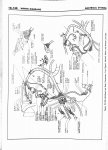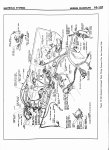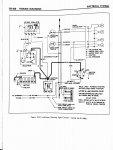Here are some detail diagrams from the '64 shop manual showing pins for the ignition switch and the bulkhead connector on the firewall. All indications are Buick and DELCO-Remy did not supply the flexible resistor wire by itself. The options were harness replacement or addition of the ceramic resistor.
A flexible resistor wire is still available for Ford products from part vendors. The resistance on it is 1.35 ohm, whereas the Buick needs a 1.80 ohm resistor. Use of the lower resistance cable can lead to burning the points in cold weather.
Guys on another website have indicated it is possible to reuse the resistor wire from a salvage yard car if one wants to cut it out of the harness. One supplier was located that can supply the stranded insulated resistor wire in various gauges and resistance values. Wire runs $1.50-2.00/ft with a 100' minimum so that approach gets pricey.
Small, inexpensive quantities of bare solid resistor wire are readily available on the Net. Strangely, the vaping community uses this wire for winding heater elements for electronic cigarettes. The problem here is the wire has to be insulated with heat resisting materials since it has to dissipate considerable heat. Doable, but would require some creativity.
The wire has to dissipate about 10 watts of heat with the engine idling. Worst case heating occurs with the ignition switch ON, engine stopped, and points closed. In that case 25 watts is developed. So the longer the wire, the better it can spread the heat. Guys on the other site indicate the lead is 6-7 ft long when installed in the harness under the hood as on the '68 Buick. The Ford cable is over 5 ft long.
Not sure what the length is when installed behind the dash in the passenger compartment as on the '64. It may be running back and forth in the harness to accommodate the extra length. The length has to be determined in order to specify the ohms/ft of the new cable.
Installing a ceramic resistor will will be simpler. To install it inside, one wire goes to the ignition switch and the other to the bulkhead connector (same places the flexible resistor hooked up).
For firewall mounting under the hood, splice the resistor in to the pink lead somewhere near the bulkhead connection. The tap for the yellow wire to the starter needs to be on the coil side of the new resistor. Then run a plain wire on the inside from the ignition switch to the bulkhead connector where the flexible resistor once was. There are other ways to do it if problems arise. Placing resistor on the firewall avoids worrying about what that concentrated 25 watts of heat (like a 25 W light bulb) may be doing back behind the dash.
Just FYI there is another flexible ballast resistor in the harness going from the ignition switch to the voltage regulator.





